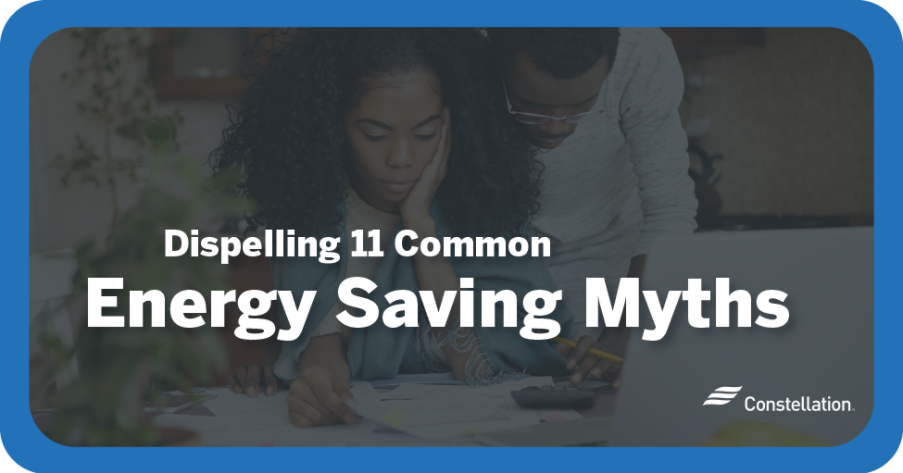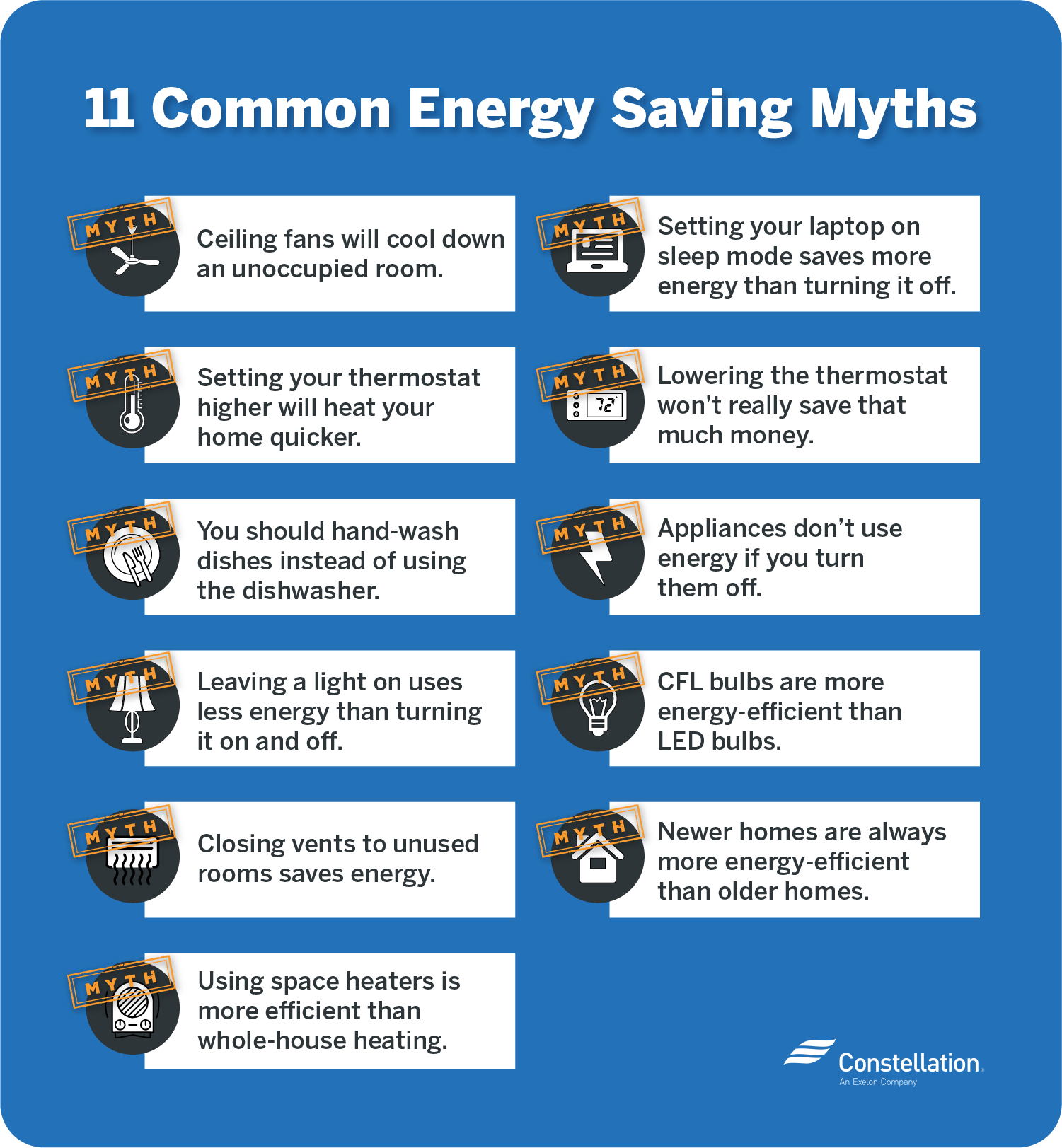
- Category:
Home Energy Savings -
Last updated:
March 21, 2022
11 Energy Savings Myths Debunked
Saving energy is good for the environment and good for your wallet. But not everything you hear is true. Unfortunately, some misinformation is widespread. These common energy efficiency myths can distract you from the good advice and, in some cases, can even run up your energy use.
The Most Common Myths About Saving Energy
Dispelling energy saving myths like the following will help you focus on what works instead.

Energy Saving Myth #1: Ceiling fans will cool down an unoccupied room.
One common energy conservation myth is that ceiling fans cool rooms. It might feel that way because they move air to increase the evaporation of sweat on your skin. But a fan cools you, not the space around you. If you aren’t in the room, the fan is just moving the air.
You can save energy by turning off the fan when you leave the room. That said, using your ceiling fan with your A/C can improve energy efficiency by more effectively circulating cool air.
Energy Saving Myth #2: Setting your thermostat higher will heat your home quicker.
Your heating system creates heat at a steady rate. Cranking up the thermostat doesn’t speed it up. If you want a room to heat up to 70 degrees, turning up the temperature to 80 won’t get there faster. In fact, if you forget and leave the thermostat turned up, your heating system will work for a longer period to reach 80 degrees, which wastes energy. The same is true of your air conditioning system – lowering it to a set point below your desired temperature will not cool your home any faster, but it will waste energy.
This is one of those energy saving myths that can cost you real money. The better choice is to turn to technology. You can save energy with a programmable thermostat that optimizes your heating (or cooling) system’s schedule.
Energy Saving Myth #3: You should hand-wash dishes instead of using the dishwasher.
When home energy myths are debunked, you can sometimes also save effort. Washing dishes by hand may seem like the economical thing to do, but you’re likely using more hot water than your dishwasher does. Today’s ENERGY STAR® appliances are designed to be extremely efficient. Learn how to properly load a dishwasher and then relax and let it work. It’ll do a better job, with less effort from you.
Energy Saving Myth #4: Leaving a light on uses less energy than turning it on and off.
This is one of those energy saving myths that’s built on misunderstanding a fact. It’s true that turning on a light causes an initial burst of energy that’s greater than the light uses while it stays on. But that burst only lasts fractions of a second. Leaving a light on can add up if you leave it on for a long time. The U.S. Department of Energy suggests that if you’re going to be out of the room for more than 15 minutes, it’s more energy-efficient to turn off the light than leave it on.
Energy Saving Myth #5: Closing vents to unused rooms saves energy.
Common energy saving myths might seem like common sense, but they can be wrong. You might think closing vents in unused rooms will save energy because your system has to heat or cool less space. But closing vents increases the air pressure in your system, which makes it work harder and use more energy.
Energy Saving Myth #6: Using space heaters is more efficient than whole-house heating.
You might ask yourself: Do electric heaters really save money? Oftentimes the answer is no. You might think it’s more efficient to lower the thermostat throughout your house and use a space heater only in the room you occupy. The problem is that even energy-efficient space heaters are likely to use more energy than your regular heating system.
Energy Saving Myth #7: Setting your laptop on sleep mode saves more electricity than turning it off.
Did you know your laptop is using significant energy even when you put it in sleep mode? Many devices are notorious electricity vampires, sucking down power when not in use. Unplug your laptop and any unused appliances when you’re not using them and stop the wasteful energy suck.
Energy Saving Myth #8: Lowering the thermostat won’t really save that much money.
This is one of the energy saving myths that falls into the category of wishful thinking. Lowering your thermostat really does significantly cut your energy consumption. Energy.gov reports that you can cut 5% to 15% of your energy usage, which translates to savings on your heating bill. Set your thermostat 10 to 15 degrees lower for eight hours or more during the colder months. Do it at night, and you may hardly notice the difference.
You can also learn how to keep your house cool without AC to help cut your electricity use in the summer.
Energy Saving Myth #9: Appliances don’t use energy if you turn them off.
Does unplugging appliances really save electricity? Yes — and in significant amounts. Nowadays, many appliances continue to draw power even when they’re in “off” mode. You can stop this waste by unplugging devices and appliances you’re not using.
Because that can be inconvenient or you might not remember to do it, this is an instance where using a smart plug can really come in handy. You can program a smart plug to cut power to an appliance or use your phone to control when an appliance will draw power from an outlet.
Energy Saving Myth #10: CFL bulbs are more energy-efficient than LEDs.
One of the newer energy conservation myths is that CFL bulbs are more efficient than LEDs. It’s true that they’re better than old-fashioned incandescent bulbs. But one of the major benefits of LED bulbs is their superior energy efficiency over CFL bulbs.
Energy Saving Myth #11: Newer homes are always more energy-efficient than older homes.
Rounding out our energy saving myths is the idea that newer homes are more energy-efficient than older ones. This doesn’t have to be the case. Although newer homes are often built to the latest standards and have new appliances, you can retrofit an older home to be just as efficient. Upgrading insulation and installing new windows and doors can absolutely transform an older home’s energy efficiency.
Saving energy is a good thing. And separating energy conservation myths and facts will ensure that your extra care pays off. You don’t want to waste energy — or effort.




